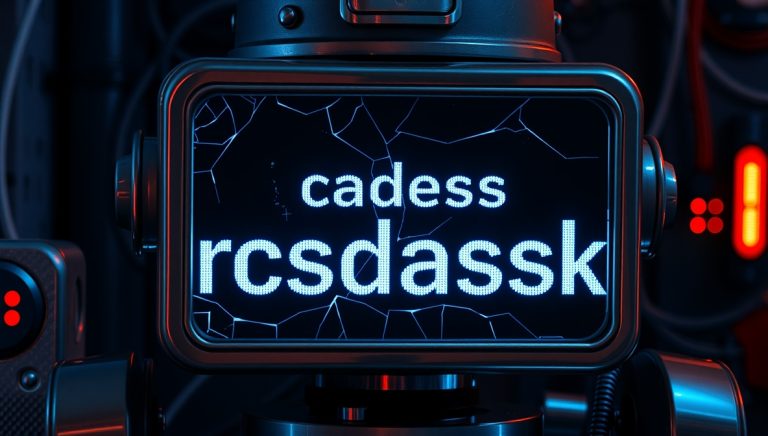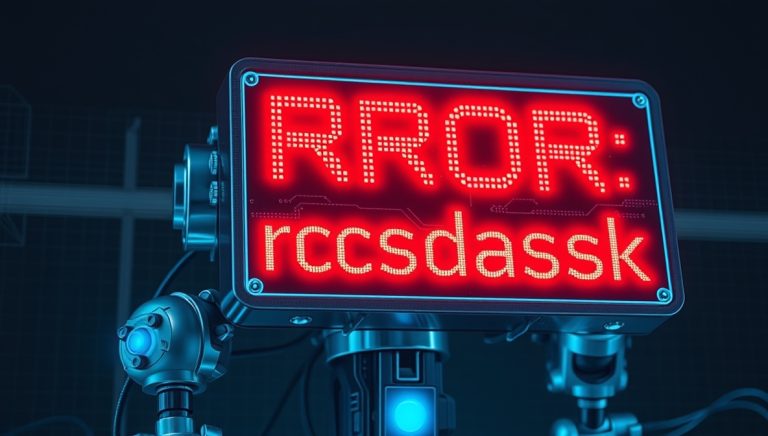How to Fix RCSDASSK Error – Complete Troubleshooting Guide
When a computer or device throws an unfamiliar error message, it can quickly turn into a frustrating experience, especially when it stops your work or affects essential system operations. One of the lesser-known yet troubling issues users face is the how to fix rcsdassk error. This issue often appears suddenly, and it can stem from various technical causes, including software corruption, driver conflicts, or misconfigured system files. In this comprehensive guide, we will explore what the RCSDASSK error means, why it occurs, and step-by-step methods to resolve it effectively without risking your data or system performance.
Understanding the RCSDASSK Error
Before jumping into solutions, it’s important to understand what this error represents. The RCSDASSK error is typically linked to background system operations related to security, driver services, or certain application dependencies. Users report encountering it during software installations, system startups, or while performing network-related tasks. The how to fix rcsdassk error challenge lies in identifying the root cause because the message may appear in different contexts depending on the device and operating system.
Many users assume that the error is caused by malware, but that’s not always true. Sometimes, a corrupted system driver or a damaged registry entry can trigger it. In a few cases, incomplete updates or interrupted installations of important system components also lead to this problem.

Common Causes of the RCSDASSK Error
There is no single reason behind this error; it can arise from multiple system-level inconsistencies. Some of the most common causes include:
- Corrupted System Files: When essential Windows or macOS system files are damaged or missing, processes linked to RCSDASSK may fail.
- Faulty Software Installations: Interrupted installations of new software or updates can trigger unexpected system behavior.
- Driver Conflicts: Outdated or mismatched drivers often create compatibility problems that cause the system to throw this error.
- Malware or Security Threats: Malicious programs can modify critical files, leading to RCSDASSK-related issues.
- Registry Corruption: The system registry stores configuration details. When these entries get corrupted, the error may appear at startup or when launching certain applications.
The key to mastering how to fix rcsdassk error is to diagnose which of these causes applies to your situation. Once that’s done, you can apply the most relevant fix confidently.
Step 1: Restart Your Computer
As simple as it sounds, restarting the system should always be your first troubleshooting step. A reboot clears temporary memory caches and allows services to restart fresh. Often, transient glitches disappear with a simple restart.
However, if the error persists after rebooting, you’ll need to dig deeper into how to fix rcsdassk error through more advanced solutions discussed below.
Step 2: Run a System File Check
Windows users can rely on the built-in System File Checker (SFC) to repair corrupted or missing system files. To use it:
- Open the Start Menu and type cmd.
- Right-click on Command Prompt and choose Run as administrator.
- Type the following command and press Enter:
sfc /scannow - Wait for the process to complete. It might take several minutes.
Once the scan finishes, restart your computer. If system files were repaired, the how to fix rcsdassk error problem might be resolved automatically.
Step 3: Update or Reinstall Drivers
Driver conflicts are a major source of this error, especially for users who recently installed new hardware. Outdated drivers can disrupt essential background services.
To resolve this:
- Open Device Manager by pressing Windows + X and selecting it.
- Expand categories like Display adapters, Network adapters, or Sound, video and game controllers.
- Right-click on the suspected device and select Update driver.
- Choose Search automatically for updated driver software.
If the automatic update doesn’t work, manually download drivers from the manufacturer’s official website. A correct driver installation often resolves how to fix rcsdassk error efficiently. rcsdassk release
Step 4: Use System Restore
If the error appeared after a recent software update or driver installation, rolling back your system to a previous restore point might help. System Restore allows your computer to return to a state before the issue occurred without affecting your personal files.
Here’s how to perform it:
- Press Windows + R, type rstrui.exe, and hit Enter.
- Follow the on-screen instructions to select a restore point.
- Confirm and restart the computer.
This process can undo problematic changes that triggered the RCSDASSK issue. Understanding how to fix rcsdassk error through restoration is one of the safest recovery methods.
Step 5: Check for Windows or macOS Updates
Operating system updates contain patches that address known system bugs and compatibility issues. Outdated systems often experience errors like RCSDASSK.
To check for updates:
- On Windows, go to Settings > Update & Security > Windows Update and select Check for updates.
- On macOS, click the Apple Menu > System Settings > Software Update.
After updating your system, restart your device to verify if how to fix rcsdassk error has been achieved.
Step 6: Scan for Malware
Malware can modify or delete essential files that trigger system instability. To rule out infections:
- Install a reliable antivirus or anti-malware program.
- Run a Full Scan instead of a quick one.
- Remove or quarantine detected threats.
- Restart your computer.
A secure and clean environment ensures your system operates efficiently. Many users who explore how to fix rcsdassk error often discover that malware cleanup was the ultimate solution.
Step 7: Clean and Repair the Registry
The Windows registry holds configurations for nearly every application and service. Over time, outdated or invalid entries can cause startup issues and application crashes.
You can manually clean the registry using Registry Editor, but it’s risky if you’re inexperienced. A safer approach is to use trusted registry cleaning tools that can automatically detect and fix problematic entries.
Performing this step carefully can significantly improve system stability, especially when investigating how to fix rcsdassk error.
Step 8: Perform a Clean Boot
A clean boot allows you to start your computer with only essential services running, helping you identify software conflicts.
To perform a clean boot:
- Press Windows + R, type msconfig, and hit Enter.
- Go to the Services tab, check Hide all Microsoft services, then click Disable all.
- Navigate to the Startup tab and click Open Task Manager.
- Disable startup items one by one.
- Restart your computer.
If the error disappears, one of the disabled applications was the cause. Gradually re-enable each to pinpoint the culprit. This method is among the most effective for those researching how to fix rcsdassk error.
Step 9: Check System Hardware
Hardware issues, such as failing hard drives or memory problems, can trigger various unexpected system errors. If you’ve ruled out software problems, test your RAM and storage drives.
Use built-in utilities like Windows Memory Diagnostic or third-party tools like MemTest86. For hard drives, run chkdsk via Command Prompt:
chkdsk /f /r
Allow the scan to finish and repair detected issues. Persistent hardware failure might require professional attention, especially for users in the United States or other regions with access to certified repair centers.
Step 10: Reinstall the Operating System
If all previous methods fail, reinstalling your operating system may be the only way to completely remove deep-rooted configuration errors. Back up your files before proceeding.
During installation, ensure you delete the existing system partition to eliminate corrupted system components. Once complete, reinstall essential drivers and software carefully. Many users who reached this step finally succeeded in resolving how to fix rcsdassk error.
Preventive Measures to Avoid RCSDASSK Error
Once you’ve successfully fixed the issue, preventive maintenance is key to keeping your system stable:
- Keep software and drivers updated.
- Avoid force-shutting down your device during installations.
- Run regular malware scans to protect against hidden threats.
- Backup your files regularly to an external drive or cloud storage.
- Use trusted optimization tools to maintain registry and disk health.
Understanding these habits ensures you won’t have to revisit how to fix rcsdassk error again in the future.
The Role of System Logs and Diagnostics
When troubleshooting complex errors, system logs can provide valuable clues. You can use the Event Viewer on Windows or the Console on macOS to review warnings and errors logged by the system.
Look for entries that match the time the RCSDASSK error occurred. Logs might reveal failing services, driver names, or software conflicts. For professionals, these logs simplify how to fix rcsdassk error since they highlight where the issue originates.
Advanced Fix: Using Safe Mode
If your system refuses to boot normally, start it in Safe Mode. This mode loads only critical system files and disables third-party programs.
To access Safe Mode:
- On Windows, hold Shift while clicking Restart, then navigate to Troubleshoot > Advanced options > Startup Settings > Restart.
- On macOS, hold Shift while restarting your device.
Once in Safe Mode, you can run diagnostics, remove problematic drivers, or uninstall recently added software. This controlled environment helps isolate factors contributing to how to fix rcsdassk error.
Understanding Software Conflicts
Many modern systems run dozens of background processes. Conflicts occur when two applications attempt to use the same system resources simultaneously. Antivirus programs, virtual private networks, and system optimizers are common culprits.
To minimize conflicts:
- Avoid running multiple security programs at once.
- Disable unnecessary startup applications.
- Regularly audit your installed software list.
Through awareness of these interactions, users gain insight into how to fix rcsdassk error by reducing unnecessary background strain.

Network Troubleshooting and the Error
In certain cases, the RCSDASSK error appears when the device encounters network configuration problems. Faulty DNS settings, firewall rules, or proxy conflicts can interfere with software that relies on secure connections.
To troubleshoot this:
- Reset your network adapter using Command Prompt with:
netsh winsock reset netsh int ip reset - Reboot your computer afterward.
- Disable unnecessary proxy settings from Internet Options > Connections > LAN settings.
Applying these steps helps restore stable connectivity and contributes to how to fix rcsdassk error when it’s linked to network issues.
User Experiences and Reported Patterns
Across forums and tech communities, users describe the RCSDASSK error in various forms. Some encounter it while updating antivirus software, others during startup. A noticeable pattern shows it often follows system updates or driver installations.
Understanding this behavior reveals why a single universal fix rarely exists. Each case of how to fix rcsdassk error requires analyzing system-specific variables, hardware models, and software environments.
Professional Diagnostic Tools
For users who prefer automated assistance, diagnostic utilities like Windows Troubleshooter, Driver Verifier, and third-party performance analyzers can identify hidden problems.
These tools simplify complex troubleshooting, making how to fix rcsdassk error accessible even to non-technical users. By running automated checks, you can quickly identify faulty drivers, misconfigured updates, or damaged registry entries.
System Maintenance Best Practices
Maintaining your device regularly can prevent many future problems. Here are a few advanced habits:
- Use Disk Cleanup or Storage Sense to remove temporary files.
- Schedule defragmentation for HDDs (not SSDs).
- Create system restore points after major updates.
- Monitor system performance via Task Manager or Activity Monitor.
Consistency is the secret to preventing future occurrences of how to fix rcsdassk error and other disruptive glitches.
When to Seek Professional Help
If none of the solutions work, or if you suspect deep hardware damage, consult a professional technician. Certified experts have advanced diagnostic tools and system recovery methods that can save time and prevent further damage.
Ignoring persistent errors may worsen system instability or lead to data loss. Timely intervention ensures you stay ahead of recurring how to fix rcsdassk error challenges.
Conclusion
The RCSDASSK error can be an intimidating problem, but with systematic troubleshooting, it’s entirely fixable. By understanding its causes—ranging from corrupted files to hardware issues—you can address it confidently using the step-by-step solutions discussed above.
Learning how to fix rcsdassk error equips you with practical diagnostic skills and helps prevent similar system failures in the future. Remember, patience and a methodical approach are your best tools when resolving complex technical issues. Keep your system updated, maintain backups, and you’ll ensure a smooth computing experience free from recurring disruptions.






